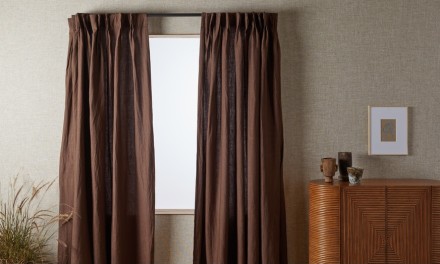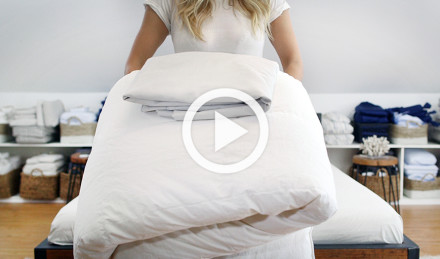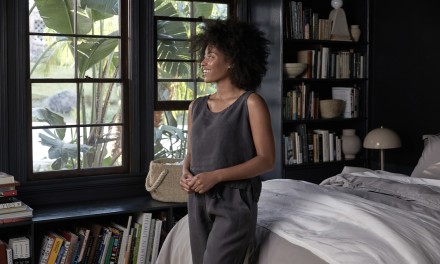Window coverings are a home design element that's undoubtedly necessary but often overlooked. Curtains in particular can make a world of difference in the look and feel of a space. Walking the line between functionality and aesthetics, they offer a finished appearance while providing light filtration and privacy.
That said, homing in on the best curtains for your space can be challenging. Whether you opt for neutral panels that ground the room or dramatic drapes that make a statement, it's worth exploring your options.
This guide will cover the different types and materials to consider, as well as curtain sizes, tips for choosing a color, installation instructions and thoughtful drapery decor ideas.
What Are Curtains?
What Are Curtains?
Curtains are essentially large pieces of fabric (often called panels) used to filter or block light, obscure visibility or separate indoor areas. In the context of interior design, curtains typically refer to panels that attach to a rod and hang over windows. They can be opened or closed throughout the day, depending on what you're trying to achieve.
What Is the Purpose of Window Curtains?
The purpose of window curtains is primarily to filter outdoor light. When sunlight shines through window panes, it can warm up a room and create an uncomfortable glare that makes you squint. The panels help minimize these effects while still letting some natural light in. Like shades and blinds, drapes also offer privacy.
In bedrooms, curtains can help you sleep by blocking all outdoor light, including street lamps and car headlights. A couple of overlooked benefits are that the cloth panels help insulate a space and absorb sound. If you've ever noticed an echo in your bathroom when your towels are in the wash, it's because the thick fabric of your bath linens usually absorbs sound waves.
Area rugs also help with insulation and sound absorption. Read our blog to discover the Best Rug Styling Ideas for Every Room.
Best Curtains: Types and Materials to Consider
Best Curtains: Types and Materials to Consider
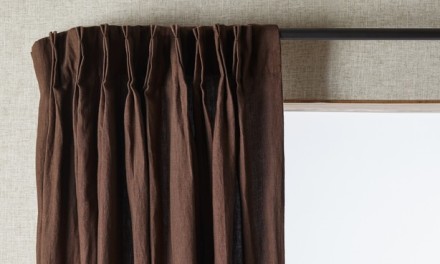
Not all panels are created equal. There are a few different kinds of drapes, as well as various fabrics to choose from, and the two often overlap. Color and size are important, but selecting a curtain material and style is a critical first step.
The main differences between curtain types have to do with transparency, meaning how much light they block or filter and whether they offer full or partial privacy. You can get panels in a wide range of textiles, but the best curtain fabrics look elegant, fall with a nice drape and are easy to care for.
Some standout options include sheers, washed linen curtains, pinch-pleated panels, opaque drapes and blackout curtains. Get details about each below, along with insight into which types are best for bedrooms, living rooms and other areas of the home.
Sheers
Often made of linen or cotton, sheers are semi-transparent curtains that diffuse outdoor light without darkening a room. They help complete a room while softening the look and lending to an easy-breeze vibe.
The lightweight material has an airiness that flutters in the wind when you leave your windows open. White window sheers are a popular choice, though white is far from the only color option. And despite its slightly summery aesthetic, the classic style works year-round in nearly any space.
The light-filtering linen curtains you’ll find at Parachute are loomed in a family-run factory in India that prides itself on producing only the highest-quality textiles. They also carry an Oeko-Tex Standard 100 label, ensuring the fabric was made without potentially toxic chemicals.
What Is Oeko-Tex? Read about the textile certification in our article.
Allowing natural light into a room can prevent a closed-in feeling. Hanging large mirrors opposite a window can also make a space look and feel lighter and brighter. See our guide for tips on How to Decorate With Mirrors Across Your Home.
Washed Linen Curtains
When it comes to the best curtains, linen is tough to beat. Naturally sourced from flax plants, the raw fibers are long and strong, giving the fabric a unique durability that actually gets softer over time.
Not too thick or weighty, linen has an inherently billowy quality that drapes nicely while allowing air to pass through. Linen’s laid-back, luxe appeal is a seasonless go-to for home furnishings.
Washed linen curtains from Parachute boast a perfect medium weight, a soft texture and subtle yarn-dyed color variation. They feature 100% flax-woven linen on the front and a 100% cotton lining on the back for enhanced light filtration and privacy. They're also conveniently machine-washable and easy to de-wrinkle with a handheld steamer.
Learn more about this beloved textile in our blog, Linen: Know Your Bedding Like a Designer.
Pinch Pleated Panels
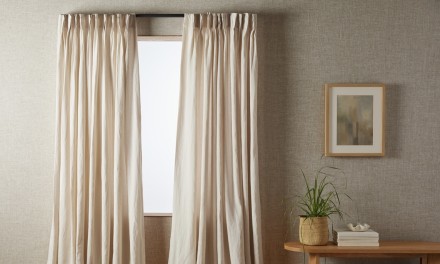
Another option is pinch-pleated panels. This type of curtain has tightly gathered, sewn-in pleats at the top. Similar to a pleated skirt, the technique creates creases at the top that drape down into soft, luxurious-looking folds.
The medium-weight pinch-pleat curtain panels you’ll discover at Parachute are woven from linen and feature cotton linings. They filter light and offer a semi-darkening effect without blocking all outdoor light. With a sophisticated yet versatile appearance, these panels work well with modern and traditional decor schemes alike. Like all Parachute fabrics, they’re also Oeko-Tex certified.
Pleated curtains can make your home look more high-end without breaking the bank. Here are 25 more Tips to Upgrade Your Apartment.
Opaque Drapes
Opaque curtains have no transparency. While they don't necessarily provide a blackout effect, they do a good job of blocking most outdoor light and offering virtually 100% privacy.
Since opaque drapes are thicker than sheers, they usually don't blow in the breeze. If you prefer a slightly heavier, drapey look or want to boost your home's insulation, these may be the best curtains for you.
Speaking of insulation, our blog has comfy-cozy tips for Layering Winter Bedding.
Blackout Curtains
As the name suggests, blackout curtains provide a complete room-darkening effect by blocking all exterior illumination. They're typically made of tightly woven fabrics and often feature double linings.
This type of drapery is a life saver for those who work odd hours or have a hard time falling asleep with any light in the room. An alternative solution is to hang lighter or more sheer panels over blackout blinds or a light-blocking roller shade.
Synthetic Curtains: What to Consider
There's no shortage of synthetic curtains on the market. While they're often less expensive than their naturally sourced counterparts and may resist wrinkling, you may sacrifice quality when you choose synthetic curtains.
Unlike household textiles you sleep under, dry off with or cuddle with on the couch, curtains don't come into contact with your skin on most days. Although feel and breathability may not be a top priority, you might be surprised by the difference in appearance with synthetic curtain materials. Premium fabrics will have a noticeably luxurious drape. And polyester sheers may look more like mesh fabric than the airy gauziness of linen or cotton.
What Are the Best Curtains for Living Rooms?
The best curtains for living rooms are panels that can be opened to allow maximum natural light or drawn to filter sunlight without darkening the space. Sheers, washed linen panels, pinched pleats and medium-weight drapes are top choices for living room curtains. In any case, they should ground the room and complement the rest of the decor.
Your furniture can act as a base for your design scheme. Here are 35 Stylish and Functional Living Room Sofa Ideas to explore. And for more tips on nailing the ambiance, check out these 27 Living Room Lighting Ideas.
What Are the Best Curtains for Bedrooms?
The best curtains for bedrooms are panels that diffuse light, provide a darkening effect or block outdoor light completely. If you want to be able to filter natural light during the day without darkening your space, consider hanging semi-transparent bedroom curtains over a light-blocking window shade or blackout blinds.
If you're designing your sleeping quarters from scratch, these Bedroom Furniture Essentials are a great place to start. Revamping your current space? Here are 37 Bedroom Decorating Ideasfor all the inspiration you need.
Where Else Should You Hang Curtains?
Aside from living rooms and bedrooms, people often hang curtains in dining rooms, guest rooms, home offices, bonus rooms, sunrooms, studios, lofts and nurseries. Light-blocking panels also come in handy in home theaters and TV rooms.
While drapes are an essential design component for most homes, you don’t need them in every single room — or on every window, for that matter. For instance, cafe curtains are sometimes hung in kitchens, but these days, shutters, shades, and blinds are a more popular choice.
Additionally, people often choose not to hang curtains over particularly high windows, small or oddly shaped windows or skylights. Many choose to forgo window coverings altogether in spaces that don't necessarily need privacy or light filtration, like laundry rooms and mudrooms.
Read our Guide to Design and Decor Ideas for Your Home for more tips. And if you need inspiration for a multi-use space, these 29 Home Office/Guest Bedroom Ideas will help get your wheels turning.
Window Curtain Dimensions and Sizing
Window Curtain Dimensions and Sizing
The best curtains aren't just made of high-quality materials. They're also the right size for the windows, walls and room as a whole. This is something people (understandably) often get wrong. But if you know what the finished look should be and follow a few basic rules of thumb, you're golden.
What Size Is a Standard Curtain?
Curtains come in a few standard lengths: 63, 84, 96 and 108 inches. Standard widths are typically 48 or 54 inches, but as long as the panels cover the entire window from side to side, width isn't quite as crucial as height.
While custom dimensions are sometimes necessary, most people have no problem finding prefabricated panels that fit their windows. Instead of focusing on average curtain sizes, it's best to carefully measure both your windows and walls before ordering anything.
Determining the Right Curtain Height
Drapes that start at the window frame and stop right below the sill tend to look awkward. Interior designers often recommend curtain lengths that start a couple of inches from the ceiling and extend all the way down to the floor, give or take an inch or two. Often described as "kissing" or "dusting" the floor, this can make the room seem bigger, the ceilings taller and the entire space more opulent.
Standard wall heights very by region, but in the U.S. they’re generally 8 feet (96 inches). The most common height taller than that is 9 feet (108 inches). If your walls are 8 feet, you can get 96-inch curtains that essentially go from ceiling to floor with no gaps.
You can also choose 84-inch panels that hang from a rod a few inches down from the ceiling and stop a few inches above the floor. For a more glamorous look, consider extra-long curtains that pile up slightly on the floor.
Drapes are a good way to fill negative space. Here are 37 more Ideas for Decorating a Blank Wall in Your Home.
Decor Considerations for Window Curtains
Decor Considerations for Window Curtains
When you think of drapery as a design opportunity rather than an afterthought, you open up a world of possibilities. Decorative curtains in a fun pattern or texture can add character to an otherwise neutral space.
Of course, some of the best curtain ideas are relatively simple, and pared-down styles tend to be more timeless. When someone walks into a room with premium window panels thoughtfully hung at just the right height, they may not consciously register this decor touch. But as a whole, they'll be left with the impression of an intentionally designed space that looks cohesive.
Still figuring out what your decor style is? Learn How to Create an Interior Design Mood Boardin our blog.
The Best Curtain Colors
Window curtains can help tie things together by calling back accent colors or finishes. For instance, rich brown panels can bring out the warmth of a burgundy accent chair or mahogany flooring. The finish of the rod and brackets can also highlight other fixtures, like lamps and doorknobs.
Leaning toward a bold hue? To prevent clashing or making your space look outdated sooner than it has to, consider a statement color that's also versatile. You could go with forest green, ochre, terra cotta, clay, olive or even black.
Having said that, curtains don't have to be the most interesting thing in a room. Neutral tones can enhance the other colors without overwhelming the space. Drapes can be the same color as your furniture or walls, slightly lighter or darker or another pared-down hue that doesn't demand a whole lot of attention. The length and material are often enough to create a striking aesthetic.
Need inspiration? Check out these 35 Stylish Living Room Color Schemes, and discover The Right Bedroom Color for You.
Curtain Headers and Hardware
Another thing to think about is the curtain header style and what type of hardware you'll use. The header is the part of the curtain at the top that attaches to the rod. The three main header types are pocket sleeves (also known as rod pockets), hooks and grommets.
With pocket sleeves, the curtain rod slides into the sleeve, which completely conceals it except for the ends. Hook headers are meant to attach to rings connected to the rod (similar to a shower curtain). Curtains often have both pocket sleeves and hooks to offer more design flexibility.
Grommets are circular openings that slide onto the rod (also like many shower curtains). Hook headers and grommets sometimes make curtains easier to open and close, but rod pockets provide a more seamless look.
If you’re buying curtains for a brand new home, our New Home Checklist covers all the essentials to buy or replace when moving into a new space.
How to Hang Curtains
How to Hang Curtains
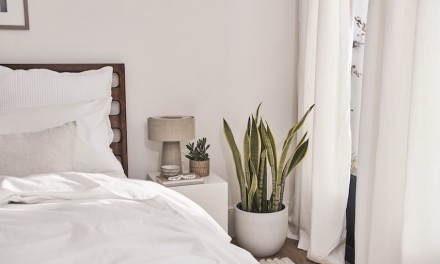
Curtains aren't particularly hard to hang as long as you have the right tools and follow a few basic guidelines. In addition to curtains and hardware (including a rod, brackets and screws), you'll need a measuring tape, a level, a pencil or tape for marking, an electric drill and a step ladder.
Here's what to do:
Extend your measuring tape to the length of the panels, then mark where you want the top and bottom hems to go. (Keep in mind grommet-style mounting will leave the upper hem about an inch above the rod, and rings will start it an inch or two below.)
Use the measuring tape and level to mark where you want the sides to start. (Rods typically extend three or four inches on either side of the window frame.) Then mark the holes where you'll screw in the brackets.
Install the brackets, making sure they're level before drilling the screws into the wall.
If you're using rings, slide the rod into place, attach the rings, then hook the panels to the rings. If you're using grommets or a pocket sleeve, slide the rod into the curtain header, then place it on the brackets.
Depending on the size, height and wall material you're working with, hanging curtains can be a tricky task to tackle alone. If you're not confident, it might be worth hiring a professional.
For more tips and instructions, see our guide to the Dos and Don'ts of Hanging Curtains.
Window Curtain Maintenance
To keep your curtains free of dirt and dust, you can vacuum them with an upholstery attachment or use a long-handled microfiber duster. Another option is to remove them from the rod and shake them out outside, though it might be tricky to avoid keeping the fabric from touching the ground.
Some of the best curtains are machine-washable and potentially dryer-friendly. However, others are dry-clean only. After washing and drying linen or cotton drapes, you can de-wrinkle them with a steamer, whether it's a clothes steamer or a handheld attachment for a steam cleaner.
Dusting curtains can be a monthly or even bi-monthly task. For deeper cleanings, once or twice a year will probably suffice. Our Ultimate Household Chore List has more tips for keeping your home clean and tidy.
Window Curtain Maintenance
To keep your curtains free of dirt and dust, you can vacuum them with an upholstery attachment or use a long-handled microfiber duster. Another option is to remove them from the rod and shake them out outside, though it might be tricky to avoid keeping the fabric from touching the ground.
Some of the best curtains are machine-washable and potentially dryer-friendly. However, others are dry-clean only. After washing and drying linen or cotton drapes, you can de-wrinkle them with a steamer, whether it's a clothes steamer or a handheld attachment for a steam cleaner.
Dusting curtains can be a monthly or even bi-monthly task. For deeper cleanings, once or twice a year will probably suffice. Our Ultimate Household Chore List has more tips for keeping your home clean and tidy.
High-Quality Curtains and Free Design Consultations From Parachute
If you're in the market for new window coverings, you've come to the right place. At Parachute, you’ll discover some of the best curtains for every room of the home, including living rooms, bedrooms, nurseries and multi-use spaces. The collection also includes sturdy, stylish hardware.
Parachute's tasteful home goods offerings go well beyond curtains. When you browse the selection, you'll find everything from luxurious bedding, inserts and furniture to rugs, baskets and decorative objects.
And that's not all. You can also get complimentary home design consultations from Parachute. Whether you need personalized drapery ideas, color recommendations or guidance on furniture arrangements, our seasoned stylists are ready to assist. Schedule your free one-on-one session today!
Read Next:
When Is It Time to Replace Your Furniture? Couches, Chairs, Beds, & More
When Is It Time to Replace Your Bed Sheets, Pillows, & Other Bedding
Best Tablecloth & Table Runner Materials, Colors, & Sizing Ideas
External Sources:
1. Fitton R, et al. The thermal performance of window coverings in a whole house test facility with single-glazed sash windows. Energy Efficiency 10, 1419–1431 (2017). https://doi.org/10.1007/s12053-017-9529-0
2. Alcaraz M, et al. (2017). Sound absorption of textile material using a microfibres resistive layer. IOP Conference Series: Materials Science and Engineering. 254. 072022. 10.1088/1757-899X/254/7/072022.
High-Quality Curtains and Free Design Consultations From Parachute
If you're in the market for new window coverings, you've come to the right place. At Parachute, you’ll discover some of the best curtains for every room of the home, including living rooms, bedrooms, nurseries and multi-use spaces. The collection also includes sturdy, stylish hardware.
Parachute's tasteful home goods offerings go well beyond curtains. When you browse the selection, you'll find everything from luxurious bedding, inserts and furniture to rugs, baskets and decorative objects.
And that's not all. You can also get complimentary home design consultations from Parachute. Whether you need personalized drapery ideas, color recommendations or guidance on furniture arrangements, our seasoned stylists are ready to assist. Schedule your free one-on-one session today!
Read Next:
When Is It Time to Replace Your Furniture? Couches, Chairs, Beds, & More
When Is It Time to Replace Your Bed Sheets, Pillows, & Other Bedding
Best Tablecloth & Table Runner Materials, Colors, & Sizing Ideas
External Sources:
1. Fitton R, et al. The thermal performance of window coverings in a whole house test facility with single-glazed sash windows. Energy Efficiency 10, 1419–1431 (2017). https://doi.org/10.1007/s12053-017-9529-0
2. Alcaraz M, et al. (2017). Sound absorption of textile material using a microfibres resistive layer. IOP Conference Series: Materials Science and Engineering. 254. 072022. 10.1088/1757-899X/254/7/072022.
